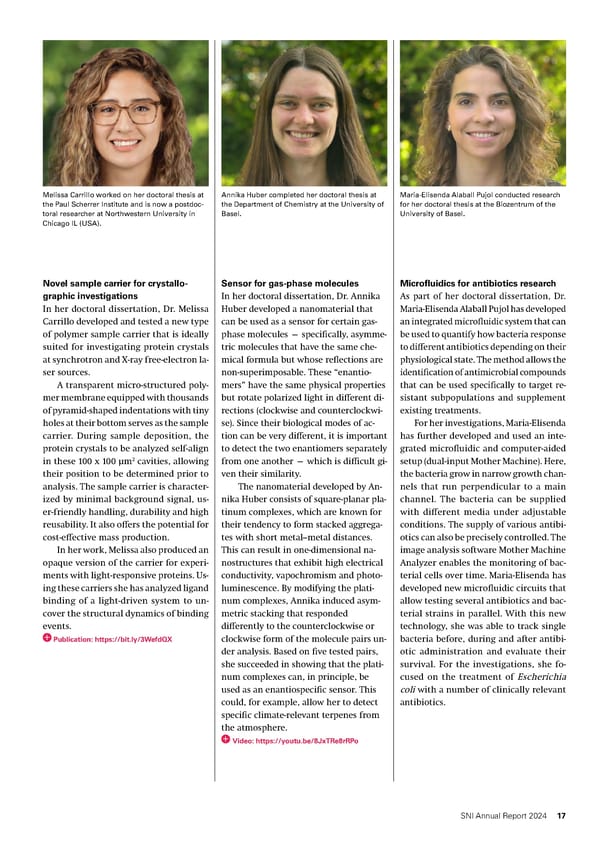Melissa Carrillo worked on her doctoral thesis at Annika Huber completed her doctoral thesis at Maria-Elisenda Alaball Pujol conducted research the Paul Scherrer Institute and is now a postdoc- the Department of Chemistry at the University of for her doctoral thesis at the Biozentrum of the toral researcher at Northwestern University in Basel. University of Basel. Chicago IL (USA). Novel sample carrier for crystallo- Sensor for gas-phase molecules Microfluidics for antibiotics research graphic investigations In her doctoral dissertation, Dr. Annika As part of her doctoral dissertation, Dr. In her doctoral dissertation, Dr. Melissa Huber developed a nanomaterial that Maria-Elisenda Alaball Pujol has developed Carrillo developed and tested a new type can be used as a sensor for certain gas- an integrated microfluidic system that can of polymer sample carrier that is ideally phase molecules — specifically, asymme- be used to quantify how bacteria response suited for investigating protein crystals tric molecules that have the same che- to different antibiotics depending on their at synchrotron and X-ray free-electron la- mical formula but whose reflections are physiological state. The method allows the ser sources. non-superimposable. These “enantio- identification of antimicrobial compounds A transparent micro-structured poly- mers” have the same physical properties that can be used specifically to target re- mer membrane equipped with thousands but rotate polarized light in different di- sistant subpopulations and supplement of pyramid-shaped indentations with tiny rections (clockwise and counterclockwi- existing treatments. holes at their bottom serves as the sample se). Since their biological modes of ac- For her investigations, Maria-Elisenda carrier. During sample deposition, the tion can be very different, it is important has further developed and used an inte- protein crystals to be analyzed self-align to detect the two enantiomers separately grated microfluidic and computer-aided in these 100 x 100 µm2 cavities, allowing from one another — which is difÏcult gi- setup (dual-input Mother Machine). Here, their position to be determined prior to ven their similarity. the bacteria grow in narrow growth chan- analysis. The sample carrier is character- The nanomaterial developed by An- nels that run perpendicular to a main ized by minimal background signal, us- nika Huber consists of square-planar pla- channel. The bacteria can be supplied er-friendly handling, durability and high tinum complexes, which are known for with different media under adjustable reusability. It also offers the potential for their tendency to form stacked aggrega- conditions. The supply of various antibi- cost-effective mass production. tes with short metal–metal distances. otics can also be precisely controlled. The In her work, Melissa also produced an This can result in one-dimensional na- image analysis software Mother Machine opaque version of the carrier for experi- nostructures that exhibit high electrical Analyzer enables the monitoring of bac- ments with light-responsive proteins. Us- conductivity, vapochromism and photo- terial cells over time. Maria-Elisenda has ing these carriers she has analyzed ligand luminescence. By modifying the plati- developed new microfluidic circuits that binding of a light-driven system to un- num complexes, Annika induced asym- allow testing several antibiotics and bac- cover the structural dynamics of binding metric stacking that responded terial strains in parallel. With this new events. differently to the counterclockwise or technology, she was able to track single Publication: https://bit.ly/3WefdQX clockwise form of the molecule pairs un- bacteria before, during and after antibi- der analysis. Based on five tested pairs, otic administration and evaluate their she succeeded in showing that the plati- survival. For the investigations, she fo- num complexes can, in principle, be cused on the treatment of Escherichia used as an enantiospecific sensor. This coli with a number of clinically relevant could, for example, allow her to detect antibiotics. specific climate-relevant terpenes from the atmosphere. Video: https://youtu.be/8JxTRe8rRPo SNI Annual Report 2024 17
 Annual Report 2024 - Swiss Nanoscience Institute Page 16 Page 18
Annual Report 2024 - Swiss Nanoscience Institute Page 16 Page 18